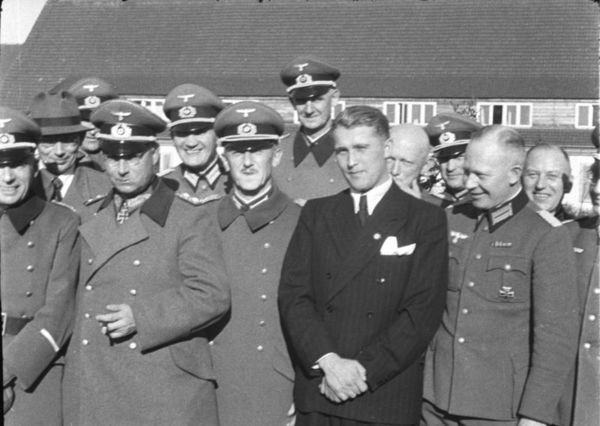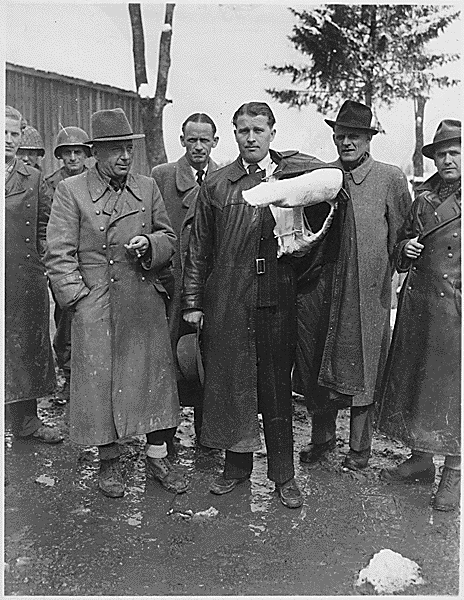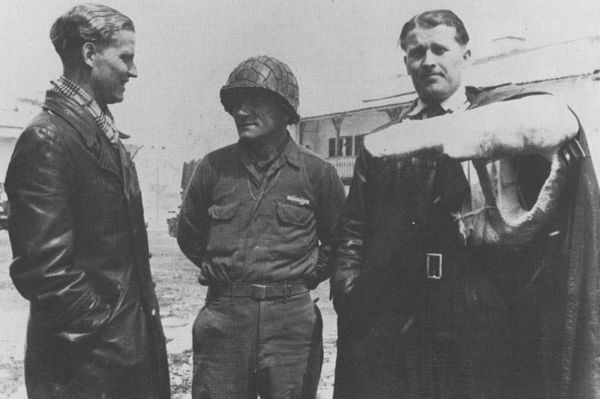How Wernher von Braun shed his Swastika (Part 1 of 2) - Occupied Germany 1945
Oct 6, 2016 13:39:38 #
In early 1945, as WW II was climaxing in Europe, Major Robert Staver received an unexpected bonanza. A Polish technician in a Nazi research lab discovered a secret list of major German scientists, which someone had tried to destroy by flushing it down a toilet. The papers -- now known as the "Osenberg List" -- were quickly forwarded to British intelligence (MI 6), then to Major Staver, who was the Chief of the Jet Propulsion Section, Research and Intelligence Branch of U.S. Army Ordnance in London.
I don't recall that James Bond ever handled secrets fished out of a toilet.
Staver compiled a "black list" of Nazi scientists to be interrogated when captured, as part of Operation Overcast. At the top of the list was a 33-year-old rocketeer, Professor Wernher von Braun, inventor of the deadly V-2 rockets.
Stationed in Peenemunde on the Baltic Sea coast of northern Germany, von Braun was the head of the giant V-2 rocket base as well as directing its underground factory, Mittelwerk, near Nordhausen in central Germany. He was technically a civilian employed by the German Army Ordnance.
The war was going badly for the Nazis in early 1945. The Allies were inside Germany, and Russian armies were nearing Peenemunde. An SS commander decided to move von Braun and his entire staff of hundreds to Nordhausen to evade the Russians. But then the American armies neared Thuringia, so the SS moved the rocketeers again, to Oberammergau in the Bavarian Alps.
The chaotic conditions enabled von Braun and his team to escape their confused SS guards and flee into Austria. On May 2, 1945, they learned that Hitler had committed suicide, so von Braun, who was suffering a serious injury (broken left arm and shoulder) from a car accident, sent his brother, Magnus von Braun, out on a bicycle to surrender to American soldiers. No rocket this time.
Magnus met Pfc Fred Schneikert of the 324th Regiment Anti-tank Company, 44th Infantry Division, who ordered Magnus to drop his bicycle and raise his hands. Schneikert took his prisoner to his commanding officer, 1st Lieutenant Charles Stewart, who quickly understood the importance of the capture. He issued safe-passage passes and sent Magnus back to bring in Wernher and the rest. The Germans were photographed and then imprisoned in a 44th POW enclosure for some days while Major Staver -- creator of the "black list" -- was notified.
About this time, Major-General Hugh Knerr, deputy commander of the U.S. Air Force in Europe, wrote a memo which impressed the Pentagon. Knerr noted that the advanced German technologies found in Occupied Germany were a revelation, and asserted that "if we do not take the opportunity to seize the apparatus and the brains that developed it and put the combination back to work promptly, we will remain several years behind while we attempt to cover a field already exploited."
General Knerr apparently had no qualms about their Nazi backgrounds. This was Part 1 of 2. The 2nd part deals with von Braun's metamorphosis via Operation Paperclip.
I don't recall that James Bond ever handled secrets fished out of a toilet.
Staver compiled a "black list" of Nazi scientists to be interrogated when captured, as part of Operation Overcast. At the top of the list was a 33-year-old rocketeer, Professor Wernher von Braun, inventor of the deadly V-2 rockets.
Stationed in Peenemunde on the Baltic Sea coast of northern Germany, von Braun was the head of the giant V-2 rocket base as well as directing its underground factory, Mittelwerk, near Nordhausen in central Germany. He was technically a civilian employed by the German Army Ordnance.
The war was going badly for the Nazis in early 1945. The Allies were inside Germany, and Russian armies were nearing Peenemunde. An SS commander decided to move von Braun and his entire staff of hundreds to Nordhausen to evade the Russians. But then the American armies neared Thuringia, so the SS moved the rocketeers again, to Oberammergau in the Bavarian Alps.
The chaotic conditions enabled von Braun and his team to escape their confused SS guards and flee into Austria. On May 2, 1945, they learned that Hitler had committed suicide, so von Braun, who was suffering a serious injury (broken left arm and shoulder) from a car accident, sent his brother, Magnus von Braun, out on a bicycle to surrender to American soldiers. No rocket this time.
Magnus met Pfc Fred Schneikert of the 324th Regiment Anti-tank Company, 44th Infantry Division, who ordered Magnus to drop his bicycle and raise his hands. Schneikert took his prisoner to his commanding officer, 1st Lieutenant Charles Stewart, who quickly understood the importance of the capture. He issued safe-passage passes and sent Magnus back to bring in Wernher and the rest. The Germans were photographed and then imprisoned in a 44th POW enclosure for some days while Major Staver -- creator of the "black list" -- was notified.
About this time, Major-General Hugh Knerr, deputy commander of the U.S. Air Force in Europe, wrote a memo which impressed the Pentagon. Knerr noted that the advanced German technologies found in Occupied Germany were a revelation, and asserted that "if we do not take the opportunity to seize the apparatus and the brains that developed it and put the combination back to work promptly, we will remain several years behind while we attempt to cover a field already exploited."
General Knerr apparently had no qualms about their Nazi backgrounds. This was Part 1 of 2. The 2nd part deals with von Braun's metamorphosis via Operation Paperclip.
Wernher von Braun in Peenemünde, 1941, sporting his Nazi party button

May 3, 1945, Wernher von Braun surrenders to U.S. Army in Austria

L to R: Magnus von Braun, Pfc Fred Schweikert(?), Wernher von Braun, May 3, 1945 in Austrian Tyrol

Oct 6, 2016 13:53:04 #
Thanks Richard for another great thread.
As an avid space cadet, I actually knew some of this already.
The toilet part was new however.
As an avid space cadet, I actually knew some of this already.
The toilet part was new however.
Oct 7, 2016 04:48:46 #
Oct 7, 2016 06:23:27 #
Oct 7, 2016 07:17:50 #
Thanks again for your wonderful history lessons. Look forward to them.
Oct 7, 2016 08:31:35 #
Oct 7, 2016 09:22:05 #
An excellent, historical account. Ready for Part 2! Thank you.
U.S. Army Air Corps (1926 – 1941)
U.S. Army Air Forces (1941 – 1947)
U.S. Air Force (1947) to present
U.S. Army Air Corps (1926 – 1941)
U.S. Army Air Forces (1941 – 1947)
U.S. Air Force (1947) to present
Oct 7, 2016 10:58:52 #
Cape Codder
Loc: Cape Cod
Loved another of your history lessons. They are fantastic. Please keep them coming!
Oct 7, 2016 12:34:33 #
RichardQ, are all of your articles collected somewhere? I suspect that your sources offer more detail for us 1930s, 1940s history nuts.
Oct 7, 2016 12:50:47 #
Oct 7, 2016 14:09:15 #
When we finally got to the moon with Apollo 11, someone said to Von Braun,
"You finally did it, Wernher, you finally hit the moon."
Von Braun replied,
"I always shot for the Moon, I just kept hitting London for so long!"
"You finally did it, Wernher, you finally hit the moon."
Von Braun replied,
"I always shot for the Moon, I just kept hitting London for so long!"
Oct 7, 2016 16:05:27 #
silver
Loc: Santa Monica Ca.
RichardQ wrote:
In early 1945, as WW II was climaxing in Europe, M... (show quote)
What has to be mentioned here is the fact that von braun was responsible for thousands of deaths suffered by the English as a result of von brauns rockets. This man was a committed nazi and that issue is important. Von braun saved his ass because of his abilities, a coward that saved himself choosing to cooperate with the Americans. There is nothing admirable about this man.
Oct 7, 2016 22:53:14 #
Thank you again Richard, your posts are deeply appreciated by so many of us.
Oct 8, 2016 13:40:43 #
BassmanBruce wrote:
Thanks Richard for another great thread.
As an avid space cadet, I actually knew some of this already.
The toilet part was new however.
As an avid space cadet, I actually knew some of this already.
The toilet part was new however.
Prof. Werner Osenberg was captured and brought to the U.S. in 1945. He gave the Americans a list of 15,000 German scientists, which was used by Operation Overcast/Operation Paperclip. He eventually was returned to Occupied Germany in 1948. Oddly, the only mention of the "Osenberg List" or "Werner Osenberg," in English-language Wikipedia or Google, appeared inside the topic of "Operation Overcast," which was picked up and repeated by a number of other pages. I turned to the German-language Wikipedia and Google, where I found an extensive posting of Werner Oskar Ewald Osenberg (1900-1974) and his "list." He was a materials scientist, an academician with a chair in the Hanover Technical Institute -- and an ardent Nazi. He joined the NSDAP in April, 1933, and the SS in June. Osenberg gained a reputation for effective research combining science and technology to improve the war effort, using a complex file card system. (This probably employed IBM punched cards, which the Nazi Party was using with their membership operations.) This was not a simple typewritten list of names. It is unclear whether the overflowing toilet in the Bonn University was jammed with paper printouts or punched cards.
By 1944, Osenberg had a cross-indexed file of some 2,000 names and skills of scientists and skilled technicians, in universities, scientific institutions, research operations, and military posts, who could be available for reassignment to more important operations. He also was able to retrieve some 5,000 scientists and technicians from ordinary military duties, pulling them away from their Wehrmacht units and back to productive use. Another 10,000 technicians in the army were designated as "essential" and shielded from being sent to the front. Osenberg now managed almost 300 people to match the technical personnel needs of critical industries to the scientists and technicians. After the war, he was celebrated for the massive "retrieval" program which saved thousands of scientists and technicians from slaughter in Russia.
Oct 8, 2016 13:44:51 #
Doddy wrote:
Very interesting Richard..thanks for posting.
Thank you, Doddy, for your interest and comments.
If you want to reply, then register here. Registration is free and your account is created instantly, so you can post right away.










